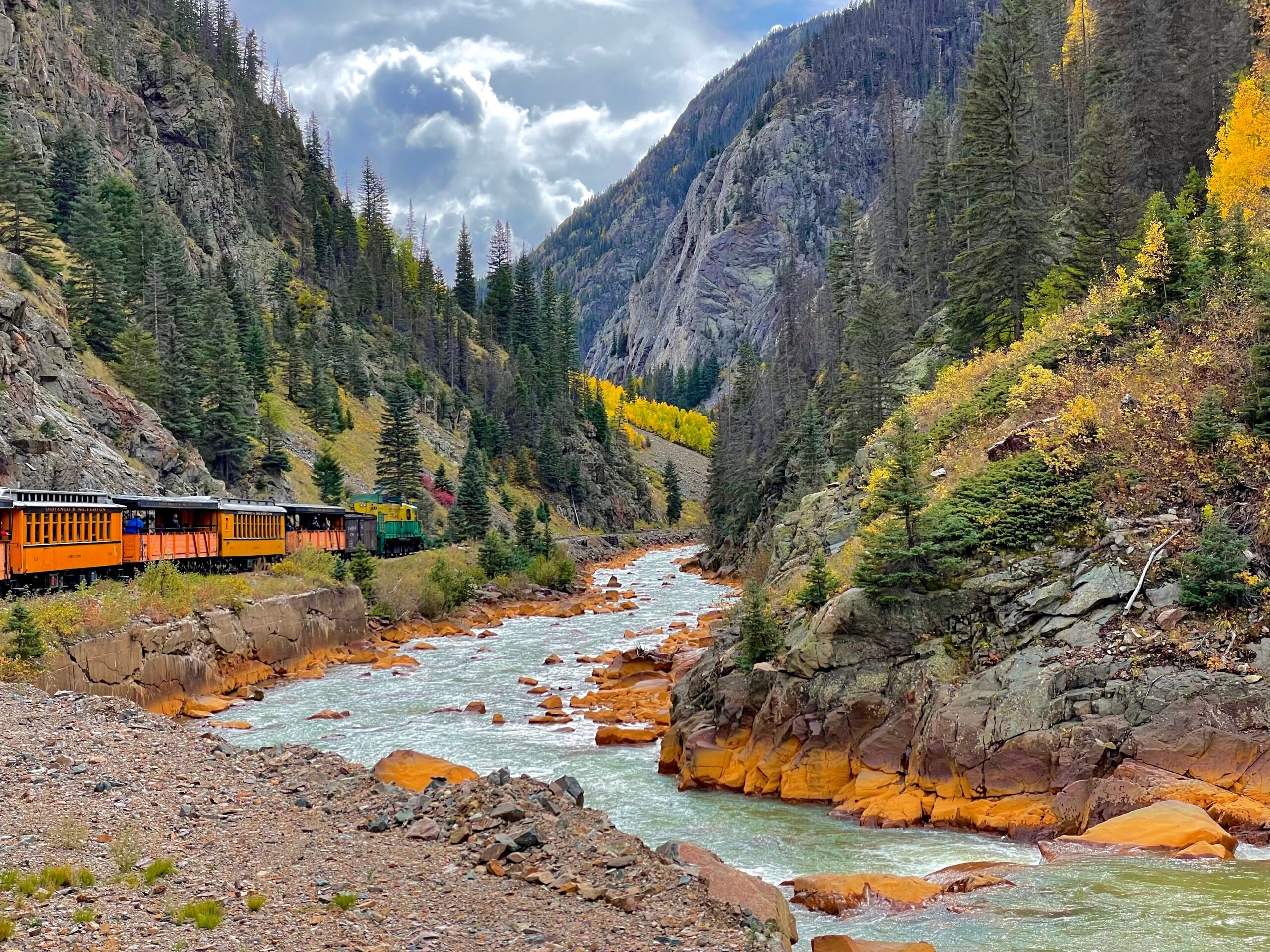Old railways have a way of capturing the imagination, especially those left abandoned in distant corners of the world. Once essential routes, these railways now lie forgotten, with rusting tracks and decaying cars blending into wild landscapes. Each one tells a story of its past—a time when bustling trains connected remote towns and carried countless travelers. Now silent, these historic railways remain as haunting reminders of a bygone era, inviting exploration and reflection on journeys left behind.
Flåm Railway, Norway

The Flåm Railway snakes through Norway’s fjord country, a breathtaking landscape filled with mountains and valleys. Originally built to connect remote communities to larger cities, the line remains a marvel of engineering. Although parts of the railway are still active, several old tracks and train cars sit idle, rusting quietly in the scenic valleys. Over time, these abandoned sections have become popular photo spots for tourists. The sight of old tracks winding into forests or along cliff sides creates a hauntingly beautiful view. It serves as a reminder of Norway’s rich rail history.
Silverton Narrow Gauge Railroad, Colorado, USA

The Silverton Narrow Gauge Railroad once brought miners and goods through Colorado’s rugged mountains. This historic line now leaves behind rusted tracks, old engines, and forgotten cars scattered in the wilderness. Built for narrow paths and tight mountain turns, the narrow gauge made the journey possible through extreme landscapes. While parts of the line are still in use for scenic rides, the remnants that aren’t have become eerie symbols of the region’s mining past. The abandoned tracks echo tales of the Colorado Gold Rush days.
Lynton and Barnstaple Railway, England

In the moors of England, the Lynton and Barnstaple Railway was a narrow-gauge marvel winding through rolling hills. Opened in the late 19th century, this railway aimed to connect small towns to the larger rail network. Though it closed in 1935, rusty tracks and old cars remain, blending into the misty English landscape. Today, visitors can see these relics, overgrown with greenery, as they explore the quiet countryside. The railway’s remains add a sense of mystery to the serene surroundings.
Darjeeling Himalayan Railway, India

The Darjeeling Himalayan Railway, known for its steep climbs and sharp turns, is an engineering gem from colonial India. Its old sections, however, lie abandoned, rusting in India’s lush hillsides. Often called the “Toy Train,” parts of the narrow gauge railway are still operational, but other sections stand untouched, a haunting glimpse into the past. Weathered by the humid climate, the rusty rails merge with surrounding greenery, giving a sense of timelessness. The decayed rail sections tell tales of adventurous journeys through the Himalayas.
Uyuni Train Graveyard, Bolivia

Just outside the salt flats of Uyuni, Bolivia, a unique railway graveyard lies open to the elements. Rusted trains and tracks, remnants of Bolivia’s early mining industry, stretch across the desert. This site was once vital for transporting silver but fell silent after mining production slowed. Now, the desolate landscape is dotted with decaying locomotives and weather-worn cars, each coated in graffiti and dust. This graveyard draws travelers seeking an otherworldly landscape and a look at Bolivia’s industrial past.
Old Patagonian Express, Argentina

The Old Patagonian Express, or “La Trochita,” is a narrow-gauge railway weaving through Argentina’s remote Patagonian wilderness. Many tracks and stations have since been abandoned, left to rust under vast, open skies. Though some parts are still in operation for tourist rides, other sections lie forgotten, reclaimed by wild grasses and shrubs. The abandoned rail cars and tracks add a nostalgic charm to Patagonia’s rugged landscape. This lonely railway reminds visitors of the days when it carried goods and people across the region.
Trans-Siberian Railway Abandoned Tracks, Russia

The Trans-Siberian Railway, the longest rail network in the world, has several abandoned sections stretching across Russia’s vast landscapes. These segments, which wind through icy tundras and forested regions, show signs of heavy wear and neglect. With some parts replaced by modern routes, the old tracks lie in decay, covered in snow and frost for much of the year. The weathered rails and overgrown stations feel hauntingly empty. Each abandoned section is a piece of history, evoking the scale of Russian rail ambitions and the desolate beauty of Siberia.
Ghan Railway Abandoned Sections, Australia

The Ghan Railway once connected Australia’s remote regions, crossing vast desert landscapes from Adelaide to Darwin. While the line still operates today, several sections have been abandoned, left to rust beneath the harsh Australian sun. These forgotten tracks and weathered sleepers sit idle, often half-buried by red sand and desert shrubs. The isolated sections reflect the rugged environment, blending with Australia’s iconic outback. Exploring these remains reveals a mix of railway history and the raw beauty of the land. Each abandoned stretch hints at the challenges faced by early rail travel through the Australian desert.
Semmering Railway Disused Tracks, Austria

Austria’s Semmering Railway, a UNESCO World Heritage Site, showcases impressive engineering through the Alps. While parts of the line are still active, several sections have fallen into disuse, left to blend with mountain landscapes. These rusted tracks wind around cliffs and bridges, surrounded by dense alpine forests. The abandoned sections offer a striking contrast against the towering peaks and sweeping valleys. As snow and rain wear down the iron rails, nature slowly reclaims the path. The railway’s ruins stand as a tribute to Austria’s rail legacy and an era when train travel through mountains was groundbreaking.
Abandoned Copper Canyon Railroad, Mexico

Mexico’s Copper Canyon Railroad was built to navigate the rugged Sierra Madre Occidental range, connecting Chihuahua to the Pacific. Some sections, however, were left incomplete or abandoned, scattered across the dramatic canyon landscapes. Rusting rails and decayed wooden sleepers can still be seen clinging to canyon edges, blending with the rocky terrain. Visitors to the area often come across these remnants, adding mystery to Copper Canyon’s scenic vistas. These abandoned tracks evoke the ambition and difficulty of building railroads through such steep terrain. It’s a testament to the challenges of early Mexican rail engineering.
Old Pilatus Railway, Switzerland

Switzerland’s Old Pilatus Railway once carried visitors up the steep slopes of Mount Pilatus, offering breathtaking views over Lake Lucerne. Though the line has since been modernized, old sections remain abandoned, now rusting away on the mountainside. These unused tracks, perched along rugged cliffs and grassy ledges, showcase the engineering marvels of the past. The aging metal blends with the alpine surroundings, becoming a part of the natural landscape. These sections remind visitors of Switzerland’s commitment to high-altitude rail travel and the early ingenuity required to navigate its peaks.
Glenfinnan Viaduct Line, Scotland

The Glenfinnan Viaduct, famed for its appearance in films, was once a vital connection across Scotland’s rugged Highlands. While the main viaduct is still in use, certain stretches beyond it have been abandoned and left to rust among heather-covered hills. These old tracks wind through isolated valleys, echoing the past journeys of Scotland’s early rail travelers. Nature has slowly crept in, surrounding the rails with wildflowers and grasses. The disused sections offer a quiet, scenic view of the Scottish Highlands. They provide a glimpse of how railways once carved paths through remote landscapes.
Abandoned Salekhard-Igarka Railway, Russia

The Salekhard-Igarka Railway, also known as the “Railroad of Death,” is an abandoned Soviet project in Russia’s Siberian tundra. Intended to connect Salekhard and Igarka, the project was left unfinished after Stalin’s death. Today, rusting tracks and decaying wooden sleepers remain scattered across the frozen wilderness. Snow and ice coat the rails for much of the year, adding an eerie stillness to the landscape. The railway’s remnants tell a tragic story of labor camps and harsh conditions faced by its builders. It serves as a haunting reminder of the ambitious and ruthless Soviet era.
Kettle Valley Railway, British Columbia, Canada

British Columbia’s Kettle Valley Railway was built to navigate Canada’s rugged mountains, connecting small communities across the province. While some sections remain as hiking trails, others lie forgotten, their tracks rusting in thick forests. These abandoned segments, often hidden beneath moss and undergrowth, blend with British Columbia’s natural beauty. The overgrown tracks wind through deep valleys and past cliffs, offering visitors a peaceful, scenic experience. Remnants of old bridges and tunnels still stand, adding a sense of history to the surrounding wilderness. The railway remains a testament to early rail efforts in Canada’s challenging terrain.
Abandoned Cambodian Railway, Cambodia

The abandoned sections of the Cambodian Railway once connected remote regions of Cambodia, playing a vital role in transporting goods and people. Decades of conflict and neglect left many parts of the line abandoned, with rusted tracks disappearing into jungle undergrowth. Old stations and bridges, overgrown with vines and tall grasses, add a haunting beauty to the scenery. The railway’s remnants hint at a past filled with travel and trade, now a forgotten chapter of Cambodia’s history. Exploring these sections offers a rare look at the country’s past, where rail once shaped lives and commerce.
This article originally appeared on Rarest.org.
More from Rarest.org
8 Largest Bacteria Ever Discovered

Bacteria are often thought of as tiny, invisible organisms, but some break this mold entirely by growing large enough to be seen with the naked eye. Read More.
20 Classic Muscle Cars That Revolutionized the Auto Industry

Muscle cars have a special place in automotive history, known for their powerful engines, bold designs, and thrilling performance. Read More.
14 Largest Octopus Species in the World

Octopuses are some of the most fascinating creatures in the ocean, known for their intelligence, adaptability, and often surprising size. Read More.
